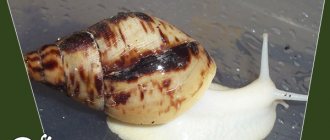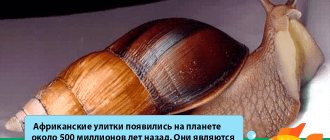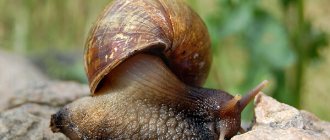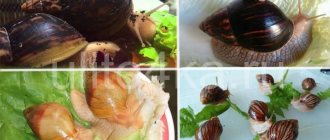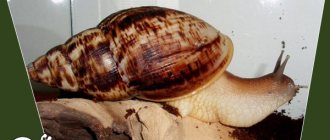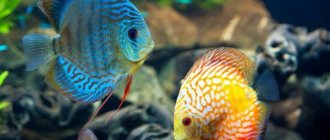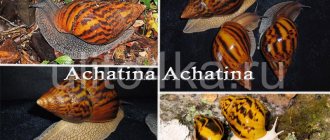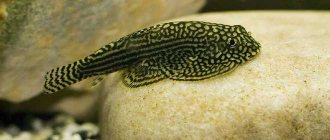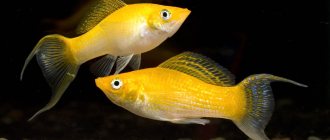Achatina snails are indigenous to the warm and humid regions of Africa. Their description has been known since the 19th century; thanks to man, they quickly populated the islands of the Indian Ocean, ending up in India, Sri Lanka and Mauritius. There are more than 60 species of Achatina in nature. Large size, beauty, interesting behavior, long life in captivity (from 5 to 10 years) have made some types of Achatina snails popular pets. Nowadays, more than eight species of these unique land mollusks are kept at home.
Origin story
This type of snail was first discovered in China in the city of Xiamen in 1930. In many countries, the Achatina Fulica snail is being massacred. This is due to the fact that snails cause significant damage to agriculture.
In a short period of time they are capable of destroying huge plantations. Achatina also cause serious damage by eating plaster from the walls of houses, since it is a good source of calcium, which is necessary for the development and growth of the shell.
Achatina Fulica is native to East Africa. Over time, its habitat expanded significantly thanks to trading ships that brought the snails to other countries.
In nature, they prefer a humid and warm climate. In Europe, due to the climate, Achatina Fulika does not live in the garden; it is kept only at home.
Types of snails
There are many types of Achatina, they differ in size, color, and sometimes character. 2-3 species are popular, the rest are rare.
Photo with species name
Common Achatina or “tiger” (Achatina achatina) Achatina Fulica (Achatina fulica) Achatina Reticulata (Achatina immaculata) Achatina Albopicta (Achatina albopicta) Iradeli or Lemon Achatina (Achatina iredalei) Achatina Glutin osa "Buraya" (Achatina glutinosa ) Achatina zanzibarica Achatina Craveni Achatina Panthera Achatina Tincta Achatina Kemovaya Achatina sp. "Cream"
Nutrition
Achatina feed on plant foods. Young snails choose green plants, while adult snails prefer dead and rotting plants.
At home, Achatina happily eats not only greens, but also vegetables, fruits, mushrooms, and cereals.
To form a strong shell, snails need to be given calcium. In the absence of calcium in the diet, Achatina can feed on each other's shells.
In order for Achatina Fulika to be active and healthy, she needs to be given grated eggshells, bone meal, sepia, food chalk, gammarus, and shell rock.
Of the vegetables, Achatina Fulika loves cucumbers most of all. You can also give zucchini, carrots, pumpkin, cabbage, tomato, peas, and corn.
Fruits include apples, pears, and bananas.
What does Achatina look like?
The most popular types of domestic snails differ in size, appearance and behavior. But in general, these are large land mollusks that grow throughout their lives. Their spiral conical shell can reach 10 centimeters or more. There are cases when Achatina grew a shell 30 cm long. As a rule, the shell is twisted counterclockwise, but there are exceptions. Every year, your pet has 1–2 new turns on its shell; in adult specimens, you can count from 7 to 9 turns.
The color of the shell depends on the species, habitat and type of food, but in general it is brown with small inclusions of yellow and dark brown.
Care and maintenance
To keep one individual of Achatina Fulica, you need a container or aquarium with a volume of 10-15 liters. When kept in cramped conditions, snails can damage their shells, which often leads to illness and even death.
A 3-5 cm thick bedding is placed on the bottom of the aquarium. Coconut substrate or sphagnum moss can be used as soil.
It is important for Achatina to maintain the necessary conditions of detention. Humidity should be around 70%, air temperature 25-28 degrees. To maintain humidity, it is necessary to spray the walls of the aquarium daily with a spray bottle.
If kept improperly, snails hibernate. They also fall asleep if you use low-quality soil. It is quite simple to bring Achatina out of hibernation; it must be sprayed with warm water.
Feeding
Achatina reticulata is quite voracious and can eat literally anything. However, despite their excellent appetite, adult snails should be fed once every two days, and young snails - every day. The following products are used as food:
- lettuce, cabbage and greens;
- carrot;
- tomatoes;
- zucchini;
- spinach;
- apples;
- peaches;
- bananas.
Shellfish must be fed with calcium, which strengthens the shell. Owners of funny reticulates often feed their pets eggshells, limestone and chalk stone. The usual chalk used in schools should not be given to snails, and it is also prohibited to feed snails citrus fruits and semolina.
Interesting fact: despite the appetite, Achatina reticulata can fast for a long time without harming its well-being.
Behavior
Achatina Fulica is active at night. During the day she sleeps, buried in the ground. Towards evening she wakes up and begins to lead an active lifestyle.
Snails often burrow in the soil and can bury themselves completely in it. They also crawl along the walls of the aquarium. Snails often fall from the walls of the aquarium. That is why a wide aquarium with low walls is chosen to keep Achatina. So that when Achatina falls from a height, it does not damage the shell. This also explains the fact that decor and decorations are not placed inside the aquarium.
Young snails are very active, they sleep little and often crawl around the aquarium. Adults are much calmer, often resting buried in the ground.
Snails of the Achatina Fulica species have long-term memory. They are able to remember the place of feeding or resting. If in nature Achatina is carried several meters away, then it is able to return back.
Diseases
Achatina rarely gets sick. With a lack of calcium, the shell is destroyed. Injury may occur if dropped or handled incorrectly. Never pick up a snail by the top of its shell; let Achatina fulica crawl onto your hand on its own. If your snail is chewing on a shell, adjust its diet and make sure your pet has enough free space. In unsanitary conditions or poor ventilation, snails are susceptible to parasites. If the snail refuses food, becomes lethargic, a white coating appears on the shell, or small translucent worms are visible near the snail’s body, immediately remove the sick individual. Rinse the terrarium thoroughly and replace the soil.
Reproduction
Growing Achatina at home is quite easy. Achatina Fulica snails are hermaphrodites. This means that they have both female and male reproductive organs. For mating, 2 mature individuals are required.
Snails become sexually mature at the age of 6 months. But such young individuals rarely mate, since the snail’s growth stops during the breeding season.
If you have a choice about whether to get Achatina, you can read the article Benefits of snails.
Description of the albino subspecies
Achatina reticulata albino body has a similar shell color to other subspecies of the Achatina family, its distinctive feature is the milky white color of the body and head, in other words, it is an albino snail. It is believed that these mollusks are not able to survive in the wild due to their conspicuous appearance.
Their shell color is light beige with dark brown spots and stripes. The shell is heterogeneously smooth and corrugated. Columella is light or colorless. They are more sensitive to temperature changes and do not grow as quickly as other types of reticulum.
Achatina reticulata has a less sensitive mantle compared to other snails, and therefore is not afraid of human touch. Moreover, she very quickly gets used to them and becomes friendly.
Rules of circulation
Proper handling of your pet, regular monitoring of the condition of the terrarium and compliance with all feeding rules will protect it from many diseases.
Giant African snail on hand
Should I pick up my pet?
It is permissible to pick up Achatina, but you must follow a number of rules:
- this must be done with great care so as not to damage the fragile shell and delicate mucus of the mollusk;
- hands should be perfectly clean, free of various bacteria, traces of sweat, residues of cream, detergents, salty and spicy foods.
Before removing the snail from the container, you need to remove pets from the premises: cats, dogs.
It is advisable that when handling Achatina, your hands are wet, which will greatly facilitate the gliding of the individual.
Bathing – necessary or misleading
Gastropods love daily water treatments, so it is recommended to equip a shallow pool in the terrarium in the form of a bowl of water. In addition, the snail needs to shower regularly. For this purpose, the individual should be picked up and held over a sink under a weak stream of warm water. This procedure should not last more than 3 minutes.
Bathing the Achatina snail at home in tap water
Achatina snail in hibernation
There are several reasons that trigger a mollusk to go into hibernation:
- severe stress, including due to sudden temperature changes;
- poor nutrition, lack of necessary supplements;
- low temperature and dry air in the terrarium;
- period of adaptation to new conditions.
Typically, hibernation in Achatina is observed in winter, when heat emanates from radiators in rooms, drying out the air. Before hibernating, the mollusk seals the mouth with a kind of film (epiphragm), formed from the produced protein elements, mucus and lime.
At the first signs that the snail is about to go into hibernation, it is necessary to increase water procedures more frequently, add calcium to the diet, and strictly control the humidity level in the house.
In a state of hibernation, the mollusk’s body is not replenished with water, which leads to a decrease in its body. Hibernation for more than 60 days can lead to the death of an individual.
How to wake a snail from hibernation
You can bring a mollusk out of hibernation by performing several actions with it:
- hold under warm running water for several minutes;
- wait for the moment when it looks out from the mouth, breaking the valve;
- place in a terrarium with optimal temperature and humidity levels;
- sprinkle with water.
You can also bathe Achatina in milk, chamomile water or whey. The temperature of any of these liquids should be +36°C. It is recommended to repeat the procedure if the snail does not leave the shell after the first time. However, many breeders question the effectiveness of this technique.
The shell of the Achatina snail as an indicator of health and what to do if it breaks
The health of a mollusk and the comfort of its living can be judged by the condition of its shell. If damage appears on the shell or its integrity is compromised, you need to use epoxy glue. In this case, Achatina needs to be provided with a diet high in calcium, adding special mineral supplements.
Problems with the snail shell: cracks, chips, scratches.
A shattered snail shell indicates its imminent death, so shellfish must be handled with the utmost care.
Feeding the Achatina snail with vegetables
